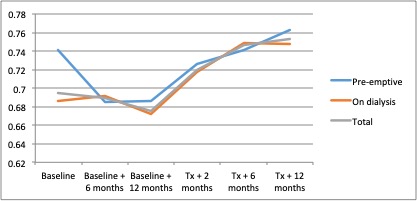Is Kidney Transplantation Actually a Cost-Effective Alternative Also for Older Patients?
1Clinic of Internal Medicine, Telemark Hospital Trust, Skien, Norway, 2Oslo University Hospital, Oslo, Norway
Meeting: 2019 American Transplant Congress
Abstract number: 281
Keywords: Economics, Elderly patients, Kidney transplantation, Quality of life
Session Information
Session Name: Concurrent Session: Quality Assurance Process Improvement & Regulatory Issues I
Session Type: Concurrent Session
Date: Monday, June 3, 2019
Session Time: 2:30pm-4:00pm
 Presentation Time: 2:30pm-2:42pm
Presentation Time: 2:30pm-2:42pm
Location: Room 210
*Purpose: We aimed to study the health economic effects of kidney transplantation in a population of kidney transplant candidates > 65 years of age.
*Methods: We performed a prospective single center study comparing costs, quality adjusted life years (QALYs) and self-perceived health during the last year before and the first year after kidney transplantation in 289 patients ≥ 65 years at enlisting. The patients completed an SF-36 survey every six months at waiting list, and at two, six and twelve months post-transplant. A health index was derived for each patient at each visit as a measure of self-perceived health. QALYs were computed based on individual health indexes and survival data from the same cohort. Average costs of continued dialysis compared to immunosuppression/follow-ups after engraftment were imported.
*Results: At time of data retrieval, 205 patients had received a transplant, 29 of them (14%) from a living donor. Median age at transplantation was 71.6 (65.0-83.6) years. Both Self-perceived health (Figure 1) and QALYs (Table 1) improved significantly after transplantation. At one year, the costs/QALY were substantially higher for transplantation (101 000 $ vs. 88 000 $). Preliminary analyses including 3-year post transplant data from 64 patients do however suggest that this is reversed completely already after two years.
*Conclusions: We conclude that compared to remaining on the waiting list, kidney transplantation is associated with improved health but also with increased costs the first year after transplantation. Preliminary analyses clearly suggest a positive long-term cost-effectiveness, but this needs to be confirmed.
| Interval | N | Health Index | QALY | QALY |
| Baseline – Baseline + 6 months | 285 | 0.691±0.11 | ||
| Baseline + 6 months – Baseline + 12 months | 285 | 0.681±0.12 | ||
| First year on waiting list | 0.686±0.11 | 0.686±0.11 | ||
| TX0 – TX + 2 months | 176 | 0.700±0.10 | ||
| TX + 2 months – TX + 6 months | 176 | 0.713±0.14 | ||
| TX + 6 months – TX + 12 months | 176 | 0.715±0.16 | ||
| First year post-transplant | 0.710±0.14 | 0.710±0.14 |
To cite this abstract in AMA style:
Heldal K, Lønning K, Tsarpali V, Midtvedt K. Is Kidney Transplantation Actually a Cost-Effective Alternative Also for Older Patients? [abstract]. Am J Transplant. 2019; 19 (suppl 3). https://atcmeetingabstracts.com/abstract/is-kidney-transplantation-actually-a-cost-effective-alternative-also-for-older-patients/. Accessed January 1, 2026.« Back to 2019 American Transplant Congress

